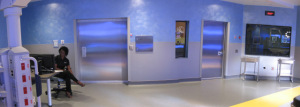by
Lauren Dubinsky, Senior Reporter | November 19, 2014

Image courtesy of ETS-Lindgren
From the October 2014 issue of HealthCare Business News magazine
When Chris Tomlinson, radiology imaging director at the Children’s Hospital of Philadelphia, received complaints from other areas of the hospital about the loud noises from their MR scanners, he knew something had to be done about it. “When you put an MR in, if you’re not shielding it you can definitely have some complaints from neighbors — they may be on the other side of the wall or even on other floors,” he says.
It’s also a reimbursement issue now that patient experience factors into how much a hospital gets paid. “Especially in this day in age when we’re trying to provide a really positive patient experience and [they] sit in the waiting room and hear all these high-pitched and varied MR noises—it’s a real challenge,” says Tomlinson.
The newer MRs on the market generate more acoustic noise than the older systems because of their more powerful gradient coils. Meanwhile, the realization and importance of shielding for that noise has become much more prominent over the last five years.



Ad Statistics
Times Displayed: 45460
Times Visited: 1359 MIT labs, experts in Multi-Vendor component level repair of: MRI Coils, RF amplifiers, Gradient Amplifiers Contrast Media Injectors. System repairs, sub-assembly repairs, component level repairs, refurbish/calibrate. info@mitlabsusa.com/+1 (305) 470-8013
Shielding the noise
“The recognition that this is a problem is now kind of putting more architects on the hook for determining the smartest way to reduce that noise from penetrating the walls into the adjacent space,” says Michael Krachon, director of Imedco.
Joel Kellogg, product line manager at ETS-Lindgren, noticed that many children’s hospitals in particular are interested in this type of shielding. “You’re dealing with young kids that you have to potentially send into an MR and just with the noise alone and the build-up to getting an MR there’s concerns about how the kids are affected by that,” he says.
A few MR shielding companies including Imedco America Ltd. and ETS-Lindgren now offer solutions for this problem. Children’s Hospital of Philadelphia installed Imedco’s SilentSHIELD doors and shields in all nine of their MR suites.
At ETS-Lindgren, they acoustically shield an MR room through general construction practices. They make sure that the rooms are constructed so that they’re airtight because the acoustic sound can escape through cracks, gaps or poorly constructed joints.
To construct the walls of the room, they use common building materials — two layers of drywall with steel studs— and make sure to carefully arrange it. They ensure that the wall structure connects the ceiling and the floor structures so that there are no cracks or gaps and fill the cavity wall inside of the RF shield with fiberglass insulation. The air ducts within the room can often be the culprit behind transmitting the noise to adjacent rooms but to avoid that they line the air ducts walls with a thick, absorbent material.

